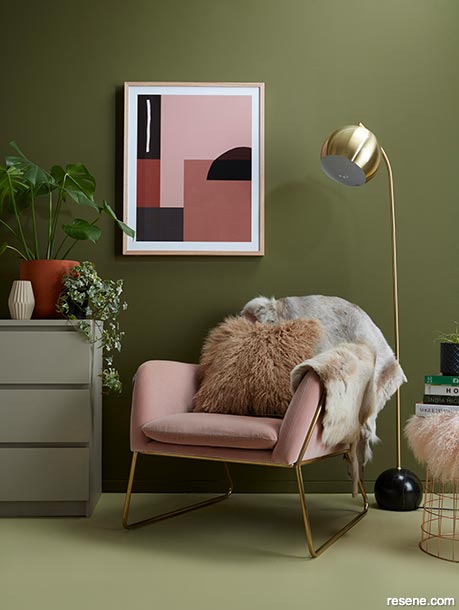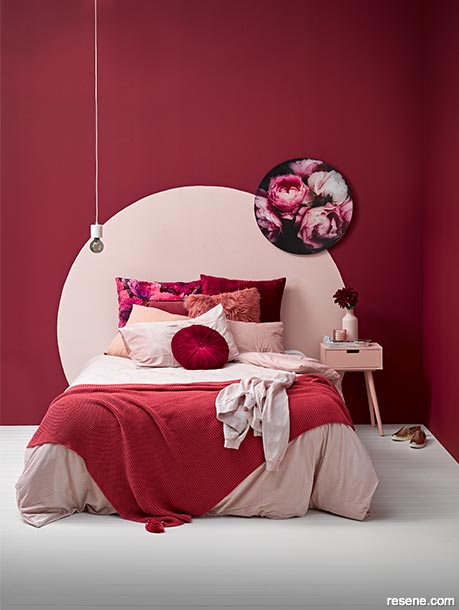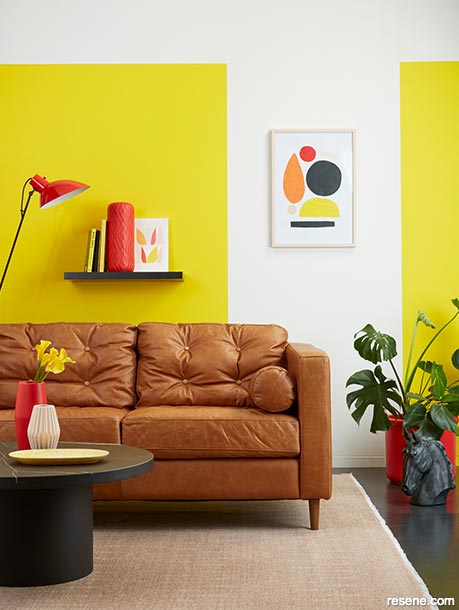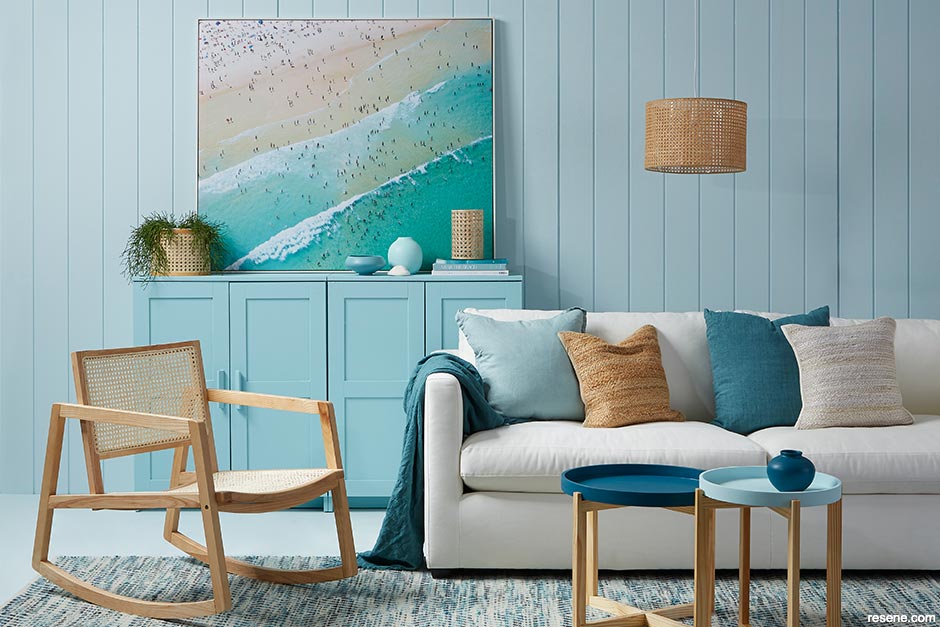From the Resene decorating blog
The final, finishing and often most fun part of any room makeover is the stage where you add the decor, mementos and art pieces that really make the space belong to you.

A muted colour palette makes the layered style of this sitting room soothing rather than busy. Walls painted in Resene Waiouru, floor in Resene Bubble N Squeak and chest of drawers in Resene Napa topped with colourful plant pots in Resene Sunbaked and Resene Double Ash. Project by Annick Larkin, image by Bryce Carleton. Armchair and lamp from Freedom, hide and artwork from Shut The Front Door, blush cushion from Lapco.
If you’re worried about taking your carefully curated new interior and turning it into a cluttered chaotic space, there are a few simple guidelines to follow. But it’s also important to remember this is your room, so you make the rules. Your best guide to when to stop adding more accessories to your space, is how you feel about it.
A cluttered space could make you feel a bit overwhelmed and as though your other design choices in colour and furniture have gotten a bit lost. A beautifully layered space is more likely to elevate and showcase your design choices and make you feel great when you enter the room.
The best thing you can do is experiment, and here are some guidelines to get you started.
In most cases you will already have one or two key pieces of decor that you want to go in your redecorated space. It might be a rug, a piece of art or a travel memento that has driven a lot of your colour and design choices from the start. Place those pieces in your room first as anchor pieces.
Play around a little with where you put them to ensure they’re showcased to the best effect. Think about lighting, window reflections and how people move around the room. The next step is to note where the obvious empty or unused spaces are in the room that make it feel out of balance or as though something is missing. You’ll know the space is out of balance if an empty or under-used space starts to pull attention from the rest of the room.
You don’t have to fill every space, it’s about finding the right combination of finishing touches in soft furnishings, light fittings, art, books or conversation pieces so that each element enhances the others, rather than having them all competing for attention.
Top tip: If you don’t know what to put in a blank space, try a plant. Plants work in most spaces as neutral design features. They work with almost any colour palette, they add texture and movement without adding fussiness, and they can soften minimalist looks and hard edges.
Once you have one or two ‘anchor’ accessories in your room, start layering with other pieces in colours that will complement or contrast with those anchors.
Add in subtle differences of texture with different finishes and fibres in your furniture and fittings; matt and glossy, wools, suede or linens, wood grain finishes and glass.

Layers of warm colour and furnishing give this beautiful bedroom an opulent, maximalist finish that is inviting rather than overwhelming.
Walls painted in Resene Pohutukawa with a painted circle bedhead in Resene Sakura, bedside table in Resene Sakura and floor in Resene Rice Cake. Euro covers, cushions, throw and light from Adairs, artwork from The Warehouse, wine round cushion from Shut The Front Door. Project by Vanessa Nouwens, image by Melanie Jenkins.

This joyful living room demonstrates that layers of bright and bold accessories can work well to showcase a classic piece of furniture and create a cohesive space.
These Resene Black White walls have been painted with blocks of Resene Turbo, while the gloss-finished floor and shelf are painted in Resene Noir. Picture frame painted in Resene Sorbet, DIY artwork in Resene Noir, Resene Roadster, Resene Turbo, Resene Party Zone and Resene Sorbet, tall vase on the shelf and large floor planter in Resene Havoc and two vases on the table in Resene Roadster (tall) and Resene Sorbet. Sofa from Cintesi, coffee table from Soren Liv, rug from The Ivy House, artwork from Endemicworld, floor lamp from Mr Bigglesworthy, cushions from Bolt of Cloth, shoes from Gorman. Project by Kate Alexander, image by Bryce Carleton.
Try adding a layer of similar colours in a mix of textures that blends with your main room colour, then add a burst of colour in one or two shades with cushions, rugs or artworks. For example if you have chosen a creamy neutral like Resene Quarter Thorndon Cream for your walls, add in a table or shelf in the deeper shade of Resene Thorndon Cream, with a selection of creamy neutral accessories, such as a vase, plant pot, with some cushions and a throw in the same shade. This will serve as a layered backdrop for a more boldly coloured couch or artwork. Then add in another layer of accessories that complement that bold colour.
Though you might end up with a room full of accessories and decor pieces, the colour scheme will help to keep it cohesive and prevent it from appearing cluttered.
There’s a great quote by famed English designer and craftsman William Morris: “Have nothing in your house that you do not know to be functional, or believe to be beautiful.”
While it might be a tricky philosophy for most of us to strictly live by, particularly if you need to accommodate things like children’s toys, it can be a good guide to what accessories – and how many – you place in your different interiors.

The key is to place things mindfully and deliberately, rather than bung something on a sideboard or shelf because you don’t know where else to put it.
What purpose does a particular cushion, artwork or ornament serve in a particular place? It doesn’t need to be too restrictive; the purpose can be simply because you love it there. Or it could be that placing something like a beautiful bowl, throw or basket in a certain spot may have an additional function, as a storage solution or simply additional warmth. The key is by putting a bit of thought into what you want to go where, you’re more likely to end up with a curated space, rather than a cluttered space.
Top tip: If you have favourite accessories but they don’t fit your colour palette, consider whether you could repaint them to suit. You can achieve a weathered and matte look with Karen Walker Chalk Colour paint and wax from Resene ColorShops or add a sleek gloss finish with Resene Enamacryl gloss waterborne enamel. Or perhaps you could rehome them into another room of your house instead.
One way to add a number of accessories and art pieces to a room without it feeling cluttered is to gather items into themed groups so they appear as one multi-faceted piece.
A good example of this is the ever-popular trend for gallery walls; a collection of art in different sizes and shapes that are displayed in a group. Though gallery walls can be made up of many different pictures, wall hangings or even wall sculptures, hanging them together creates the impression of a single eye-catching artistic feature. In fact, far from looking cluttered, gallery walls can be a fantastic way to add interest to walls or rooms that could otherwise be uninteresting, such as hallways or toilets.
The tip to creating an effective gallery wall is to place your items together on the floor first to work out what looks best where; then take a photo as a reference when you go to hang your pieces.
In creating any group of accessories, the key to them looking collected instead of cluttered is to identify a theme that pulls them together. It could be colour, a style or pattern. It could be items you collected from a particular part of the world, or a particular artist. It doesn’t need to be an overt theme that makes sense to everyone. If you understand what connects the pieces, your design choices will flow from that and the space will come together.
Paint the frames with Resene testpots or Resene Lustacryl to give them a common look. This will help to tie together different thicknesses and styles of frames.
March 10, 2022
Visit your local Resene ColorShop for expert advice and all the products and accessories you need to make the most of your home.
Book a colour consult | Ask a Colour Expert | Ask a Paint Expert
Resene's decorating blog
Paint your home beautiful! Discover the latest decorating trends, tips and colour news.
![]()
Previous «
Design ideas for maximum storage
![]()
Blog home
View the latest trends, tips and news
![]()
» Next
On-trend autumn colours to fall in love with